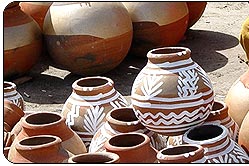|
|
|
I was forced to research where our community
which we belong to came from and was derived and I am glad now we did
as lots of new and updated information. There are many stories and derivations
as how we came to be and as time moves on this tends to change slightly.
From the research I did this is what was found.
SSPG stands for Shree Sorathia Prajapati Gnati
and the most important part in this acronym is the the last two words
Prajapati and Gnati as this is our community and where many of us belong
to. Sorathia comes from people who stayed and lived in Sorath.
Firstly we need to look at the word Prajapati
as this name appears in several places along the history time line and
there are artifacts that link the name to the non-Aryan Shiva which
the ruins in the Indus Valley Civilization known as Pakistan today.
In Hinduism, Prajapati is Lord of Creatures,
thought to be depicted on ancient Harappan seals, sitting in yogic posture,
with an erection and what appear to be bison horns. Like the Biblical
Adam, he is in close communication with Nature and Nature revolves around
him.
In the Vedas, Prajapati is the name of God as the sustainer of all beings.
This would identify him with the later Hindu god Vishnu.
Prajapati has also been associated with the non-Aryan Shiva. The presence
of hundreds of what appear to be shivalinga discovered amid the ruins
of hundreds of Harappan cities and villages located in the Indus Valley
Civilization in what is today known as Pakistan would seem to reinforce
the identification of Prajapati with Shiva.
Also in Hinduism, the Prajapatis are a group (or one) of creation gods,
children of Brahma, including Daksha.
Now the important part here is the children of Daksha and Brahma. As
this would let us go further into where the story first began.
In Hinduism, Daksha, that is the skilled one, is an ancient creator
god, one of the Prajapatis, the Rishis and the Adityas, and a son of
Aditi and Brahma.
With his wife Prasuti, he is the father of many
daughters, twenty-seven of whom were married to Soma. Daksha found that
Soma overly favored one daughter (Rohini) over the others, thus neglecting
their needs and flouting his responsibilities. For this, Daksha cursed
him to wither and die. The daughters intervened and made his death periodic,
symbolized by the waxing and waning of the moon.
In later Hindu tales, Daksha is said also to be an ancient king of great
repute and power. One of his daughters (often said to be the youngest)
was Sati or Dakshayani, who had always wished to marry Shiva. Daksha
forbade it, but she disobeyed him and did so anyway, finding in Shiva
a doting and loving husband. Daksha disliked Shiva intensely, calling
him a dirty, roaming ascetic and reviling the great yogi's cohort of
goblins and ghouls.
From then on, he distanced himself from his daughter
and his son-in-law. This enmity culminated in a great sacrifice he had
been hosting, one to which he invited all and sundry, family and allies,
gods and rishis, courtiers and subjects. Consciously excluding Sati
from the list, he also set up a statue of Shiva, which he defiled and
mocked, at the entrance to his hall. Sati, ebullient at the thought
of such a great event, and assuming that the daughter of the king was
welcome no matter what, attended the festival. Snubbed by her father
and treated with disdain, Sati nonetheless maintained her composure.
Indeed, even her father's refusal to invite Shiva, her husband and thus
a traditionally honored member of any Hindu family, was to some extent
borne.
However, on seeing the shameless insult to her husband in his absence,
and the repeated slights King Daksha and his courtiers railed at Shiva,
she committed suicide in grief for her beloved. Hearing of the news
Shiva attendents rushed inside the ceremony hall and started to attack
all the guests present there, however, the demons invoked by Bhrigu
defeated Shivas attendents and they retreated back to his abode. Upone
hearing the news of his beloved wife's death, Shiva Infuriated that
Daksha would so callously cause the harm of his (Daksha's) own daughter
in so ignoble a manner. Shiva grabbed a lock of his matted hair and
dahsed it to the ground. From the two pieces rose the ferocious Veerabhadhra
and the terrible MahaKali. Upon Shiva's orders they stormed the ceremeny
and killed Daksha as well asmany of the guests and defeated all the
Gods including Vishnu, Bhrama, and Indra. Terrified and with remorse
Bhrama and Vishnu propitated Lord Shiva and begged his mercy to restore
Daksha's life and to allow the sacrifice to be completed. Shiva restored
Daksha's life, with the head of a goat.
In his humility and repentance for his graceless and sinful acts, Daksha
became one Shiva's most devoted attendants. Sati/Dakshayani later incarnated
as Parvati in her next life and remarried Shiva, thenceforth never to
part with him again. It is for this reason that Shiva, while monogamous,
has had two wives in reality, but the same soul in two incarnations.
So we now know where Daksha came from and now
we need to find more information about Brahma.
Brahma (written Brahma in IAST transliteration)
is the Hindu creator god, and one of the Trimurti, the others being
Vishnu and Shiva. It must not be confused with the Supreme Cosmic Spirit
of Hindu philosophy Brahman (the root of both words is the same). Brahma
is identified with the Vedic deity Prajapati.
Some of the surnames
that belong to the Prajapati communities:
In past, from Prajapati community some people came in touch with the
Ksatriyas, and they started to work like them, so people who mixed with
Shatriyas and attained a similar surname. For example Saurastra and
Kutch, in Prajapati community there is a surname like Chavda, Vaghela,
Solanki, Gohil, Parmar, and these surnames are recognized as such even
at present. The following surnames in the Shree Sorathia Prajapati community
are being used and obtained through heritage for centuries:
Bhalsod, Bharadwa, Bharadwaj, Buhecha, Chandegra, Chavda, Chhaya, Chitroda,
Chohan, Dabhi, Devalia, Dhokia, Dodia, Fatania, Gadher, Gadhia, Ghadhvana,
Ghedia, Girnara, Gohil, Gola, Jagatia, Jethwa, Jogia, Kamalia, Kansara,
Kataria, Kholia, Koria, Kukadia, Ladva, Majevadia, Mandora, Mavadia,
Maru, Nena, Oza, Pankhania, Parmar, Pithia, Poria, Rathod, Ravat, Sarvaiya,
Savania, Shingadia, Solanki, Taank, Vadher, Vadukul, Vara, Vegad, Visavadia,
and Yadav
The people who were working in the masonry or carpentry occupations
were given the title of a mason, carpenter, or masonry etc., and they
are known by these names even at present. The people who worked as potters,
making utensils, tiles or any related products from earth were called,
"Kumbhkar." Kumbh - means clay utensils and kar - means maker.
Therefore, Kumbhkar was later called,"Kumbhar." Due to the
increase use of their trade and that became well known as, one "Jati"
people of Prajapati community it appears that their geographical location
determined their title such as Sorathia, Lad, and Varia. Therefore,
people who stayed and lived in Sorath were known as "Sorathia Prajapati."
More information can be found at: www.sspgm.net
|
|
|
|
|








 .
. .
. .
.
